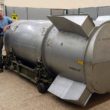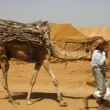Don’t Call the Cavalry
Homicides have soared since the president deployed the army in Juárez in January of 2008. In 2007 there were 317 reported killings; in 2008, 1,623; in 2009 the number reached 2,754.
Judith Torrea is a Spanish journalist who reports on drug-trafficking, organized crime, the death penalty, and immigration. Her work has appeared in Univision Online, the Mexican magazineLetras Libres, the news agency DPA, the Texas Observer, and other publications. She has covered Ciudad Juárez and the U.S.-Mexico border for 12 years.
Her award-winning blog, Ciudad Juárez en la sombra del narcotráfico,https://juarezenlasombra.blogspot.com/ is a daily account of life in what many consider the most dangerous city in the world. On April 19, Torrea was awarded an Ortega Y Gasset Prize, the most prestigious journalism award in Spain. Her article is translated from the Spanish by Lou Dubose.
By Judith Torrea
HE PULLS UP IN HIS OLD CAR. Twenty minutes earlier on his scanner he had picked up “The Lord of the Skies”—a popular narcocorrido that drug traffickers broadcast on police frequencies to warn of killings. Then a voice that says “La Línea“—the armed muscle of the Juárez Cartel. Everything he does begins with the police scanner he monitors to do his work. Then the dispatcher announces a “30-55 on Ejército Nacional.” Ejército Nacional is one of the city’s principal streets. 30-55 is the dispatchers’ code for a dead man.
He steps out of the car. He finds three bodies on the ground. The family wailing. The children hanging close to their parents, hoping to catch a glimpse of the spectacle of death from behind the yellow police tape with black letters warning “danger.” The soldiers arrive. The Federal Police arrive. A forensic detective arrives, along with the technician who photographs the cadavers and tries to gather the physical evidence before the bodies are hauled away.
Just like most of the murder scenes he’s worked. The only thing missing is popcorn for the neighborhood kids—to make it all seem like a Hollywood movie. But here in Juárez death is too real. He knows it. More than 5,000 violent deaths since President Felipe Calderón declared his so-called war on the narco-traffickers and ordered the Mexican Army to fight it. More than 650 deaths already in the first three and a half months of this year.
He comes a little closer, circles the crowd to see who is crying, who might be family members, who might be close friends. He moves efficiently, wasting no time because he knows someone else might show up and beat him to the job.
Adrián Arturo is a buitre, a muertero—a “vulture,” a “corpse collector.” This year alone three of his colleagues were gunned down after they beat federal forces to crime scenes. No one seems to know who killed them. Maybe the Juárez Cartel, maybe the Sinaloa Cartel—the two groups disputing the lucrative trade routes that move Colombian cocaine into the United States.
(Since Sinaloa Cartel boss Chapo Guzmán rode a laundry truck to freedom from a maximum security prison in 2001, he has fought to recapture the leadership position he once held and has become one of the world’s wealthiest men, according to Forbes.)
In a city that measures time by the rhythm of six to 15 assassinations a day, Arturo’s work consists of finding the families of the recently executed and connecting them with one of the city’s many funeral homes. The cheapest funeral, which goes for 4,500 pesos ($300), is preferred. He gets 500 pesos ($35) for each successful deal he makes.
“You don’t feel anything, it’s a job,” Arturo, 22 years old, told me.
AN ECONOMY OF HUMAN CAPITAL—Until two years ago, Arturo was a disc jockey in one of the hundreds of Juárez bars that lit up the night for Mexicans—and for Americans who crossed one of the three international bridges that separate Juárez from El Paso.
The former DJ found himself unemployed one morning when the club where he worked was torched after its owner failed to make the biweekly extortion payment demanded by local criminals.
Arturo thought about looking for work in another club. But the economic and drug crisis had been inflamed by arson and extortion and exacerbated by Juarenses’ exodus to the interior of Mexico or to the United States. And by American day-trippers’ fear of leaving the second most secure city in the United States for a night on the town in the most dangerous city in the world.
Jobs—not just jobs in nightclubs—were hard to find. Thirty percent of businesses in Ciudad Juárez are shuttered, according to the Mexican National Chamber of Commerce. And more than 116,000 houses are abandoned, according to figures provided by Juárez’s municipal government.
Arturo opted for self-employment. Today, most of the bodies he goes looking for end up in one of the 10 funeral homes to which he offers his services. They are all located in the city’s working-class colonias, home to workers in the 250 maquiladoras that exploded onto the scene in the 1970’s.
These assembly plants built by foreign capital create First World wealth at Third World costs in a city that lives by the economic pulse of U.S. industry. The average salary for a maquiladora worker in Juárez is 700 pesos a month—approximately $65. You can be sure that it costs more than that to live here.
The lack of opportunity for children of working-class families that traveled from the interior of Mexico in hope of finding work translates into 700 gangs, whose ranks are filled by some 17,000 kids and young adults who can’t resist the gravitational pull of the Juárez Cartel.
Some consume the product the Cartel puts on the street. Others manage to stay away from hard drugs. For all of them, their identification with the Cartel is the only way to survive in a desert city where hope has dried up. It’s not just their dreams that are dying. The majority of murder victims in Juárez lose their lives between the ages of 18 and 25—an entire generation of kids at risk when they step out of their houses.
Yet you don’t have to leave your home to lose your life. February 2 was one of the hardest days I’ve endured in 12 years covering the brutal reality that is Ciudad Juárez. It wasn’t that I saw more bodies, nor more blood, nor more decapitations. I attended the funeral of eight students, eight of 15 kids executed while celebrating a birthday at a party chaperoned by their parents.
Eight open graves awaited eight coffins, as friends and family numb with grief stood by. When the hundreds of mourners walked away from the gravesites, it occurred to me that this moment was a metaphor for a city that itself has become death. Cemeteries are the places where we socialize. Very few Juarenses dare go to a park, a restaurant, a café. In the city’s cemeteries, we come together as a community.
BLAMING THE VICTIMS—When President Felipe Calderón learned about the massacre, he told reporters at a press conference that the victims had been gang members and were connected to organized crime.
The president was working a meme that has made the loss of life more acceptable. In the so-called war against the narcos, every murder victim in Ciudad Juárez somehow ends up linked to a secret life in the drug underworld, so no investigation into the nature of their violent deaths is necessary. (A notable exception was the three recent murder victims associated with the U.S. consular office, whose diplomatic credentials saved them from all-too-common, post-mortem guilt by association.)
Reporters report what we see. On most occasions we can neither attend the funerals nor investigate the cases—and by so doing return some measure of the dignity wrested from the city’s many murder victims. What I saw at the San Rafael Cemetery were inconsolable companions of kids gunned down at a birthday party. Their innocence suggested they were closer to childhood than adolescence; the cut of their clothes and their level of education suggested the daily grind that is life in the Villas de Salvácar colonia, where those fortunate enough to have work work in maquiladoras. The wholesale horror of the slaughter of innocent children turned out the city’s reporters who turned out accounts of what actually happened.
Within two weeks, President Calderón was forced to react. His war on drugs (the centerpiece of his administration) had resulted in 22,000 violent deaths, many of them in Ciudad Juárez, and was being questioned as never before across all of Mexico. Those were the circumstances behind the president’s first visit to this city since his inauguration three years ago. He promised a new program: “We are all Juárez. We will rebuild the city.” The plan that he said would begin to bear fruit within 100 days has yet to fulfill any one of its promises.
The presidential visit began with a meeting with the victims’ families. It was done behind closed doors, with no press and with the staff of Casa Amiga, the nonprofit group selected to organize the meeting, locked in their kitchen. “They didn’t let us attend the event and we were guarded by soldiers who made sure we didn’t leave our own building,” said Casa Amiga director Irma Casas.
At the meeting, the government offered to pay the utility bills of the victims’ families, arrange for U.S. tourist visas, and cover travel costs to destinations in Mexico or the United States, according to several family members who attended.
SPEAKING TRUTH TO POWER—Everyone accepted the president’s offer, with one exception. “The death of my two children is not for sale,” said Luz María Dávila, a maquiladora worker who lost her only two children: Marcos and Jose Luis Piña, ages 19 and 17.
Dávila, an extremely timid woman, had allowed me to attend the wake she arranged for her sons in the kitchen of her small home, where two coffins were separated by a refrigerator. She managed to slip in unnoticed to an earlier meeting President Calderón held with 400 of Ciudad Juárez’s leaders, to which the press was invited.
She jumped the security cordon and without interruption said, before the president and the gathering of national, state, and local authorities:
Excuse me, Mr. President, but I’m not extending my hand because you are no friend of mine. And I’m not welcoming you because you’re not welcome here …[Mayor] Ferriz and [Governor] Baeza always say the same thing but they do nothing, Mr. President, and I don’t have justice. What I have is two dead children, and I’d like you to put yourself in my place …
It’s not just that my two boys were killed at a party—and I want you to apologize for saying what you said, that they were gang members. It’s a lie! One was in prep school, the other in the UACH [Universidad Autónoma de Ciudad Juárez]. They weren’t in the streets; they studied and worked.
For two years here they have been assassinating people and doing other things and no one does nothing. I only want you to provide justice, not only for my two boys but for everyone.
The president managed to say, “of course.” But the grief-stricken mother interrupted him: Don’t tell me “of course.” Do something! If someone had assassinated your son, you would be turning over every stone looking for the assassin.
CAN JUÁREZ BE SAVED?—Hugo Almada, a professor at the Autonomous University of Ciudad Juárez, attended the same meeting. Speaking to the president, Almada reiterated the necessity of combating corruption and of conducting investigations in order to arrest people, rather than arresting people in order to conduct investigations.
(Crimes in Juárez, in fact, are rarely investigated. When there is pressure from the public, police round up “suspects” and torture them until they confess before the public and the media—at an event known as “a presentation.” The events are often so carefully staged that government agents planted in the crowd ask all the questions, to shut out legitimate questions from reporters.)
Almada also told the president that the deployment of force, as was done in Operation Chihuahua United, the anti-narco campaign led by the Mexican Army, is an ongoing disaster condemned to failure. According to Almada, President Calderón had at least taken note of his comments.
“What President Calderón said was that the [military] operation didn’t create the violence but was a response to violence that existed,” Almada stated in an interview. “Yet there is no doubt that after the operation, instead of decreasing, the violence had greatly increased. The public knows this operation has failed. Not only has it failed, but it has no possibility of succeeding because as conceived it is a war against the poor, and this war against the poor is very costly.”
Homicide statistics have soared since the president deployed the army in Juárez in January of 2008. In 2007 there were 317 reported killings; in 2008, 1,623; in 2009 the number reached 2,754.
President Calderón’s campaign is not the first failed attempt to arrest violence in this city of 1.3 million. For years young women, most of them poor and beautiful, have disappeared in horrifying numbers, while authorities responded with indifference. The narco-murders and the failed government response to them has democratized violence in Juárez, adding thousands of deaths to the 500 women abducted and murdered over the past 16 years.
The phenomenon that has come to be called feminicidio continues in Juárez, though relegated to second place by the daily assassinations fueled by drugs and the drug wars, according to Oscar Máynez, who for a year and a half served as chief of forensics and legal medicine for the city government. Máynez resigned after discovering that false evidence was planted to convict two innocent men for the murder of eight women. The two attorneys representing the men were later assassinated.
Máynez, now a professor at Juárez’s Autonomous University, said the deteriorating conditions in the city demand new strategic policy initiatives: “I don’t understand how, after investing so much money and mobilizing thousands of police and soldiers, the situation has only gotten worse.”
Like the criminologist who gave up on government service, the public knows what actions might save this city and has been clamoring for them since I arrived here 12 years ago: an anti-poverty campaign; a functioning legal system; and confronting corruption at all levels, from politicians to the security forces. And now, some measure to control the latest perversion in this war on drugs: federal forces that constantly violate the human rights of the residents of this suffering city. There are no quick solutions for the tragedy that is Ciudad Juárez. Until the government acts, the buitres of this city will have more work than they can manage.
Editor’s Note: In mid-April, President Calderón reiterated his contention that most of those killed are not innocent civilians but instead linked to the drug war and the cartels battling for control.
Translated by Lou Dubose






0 Comments